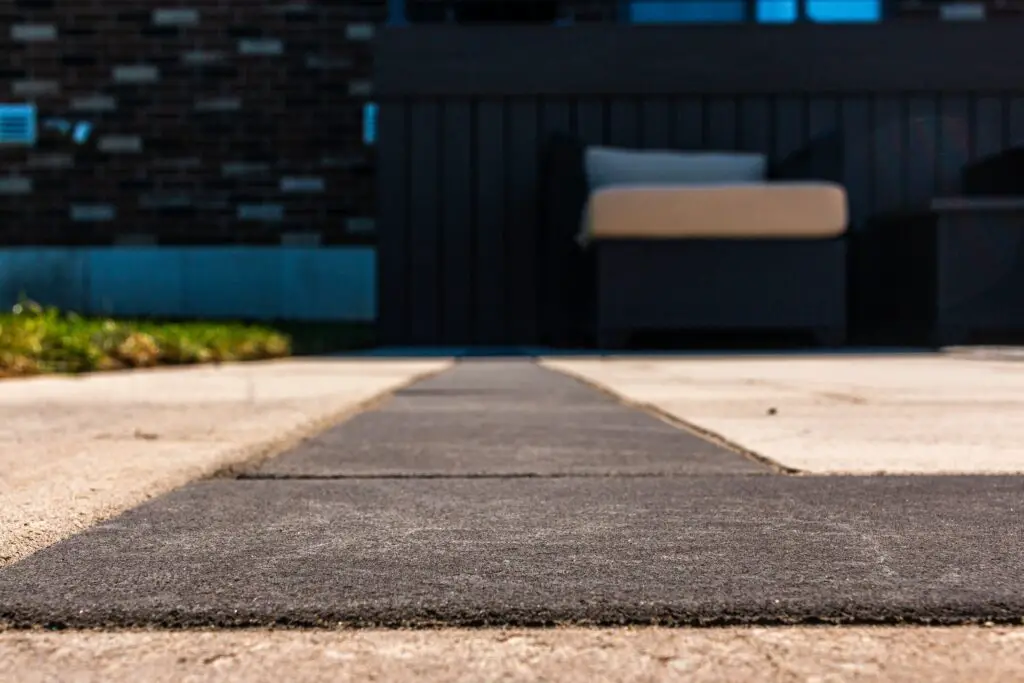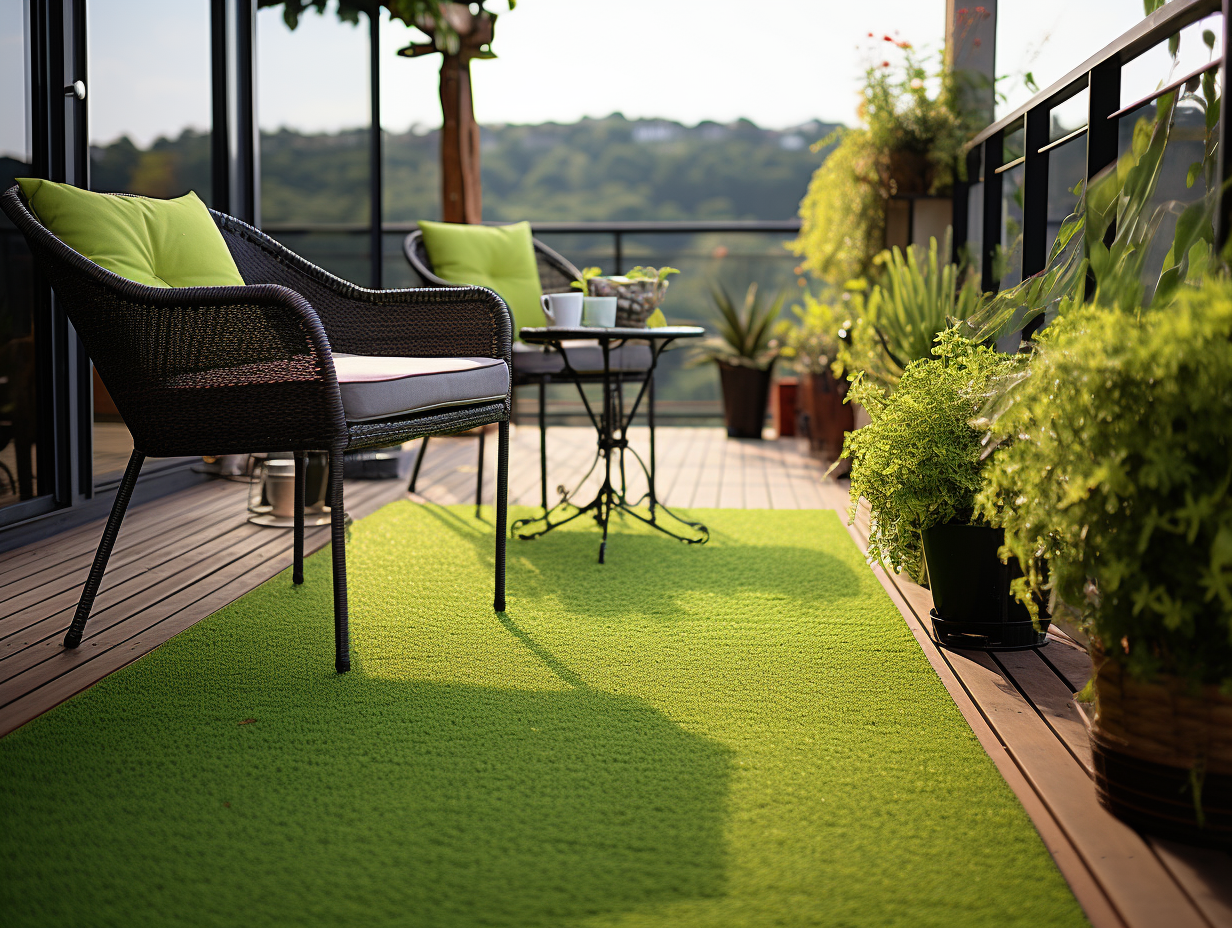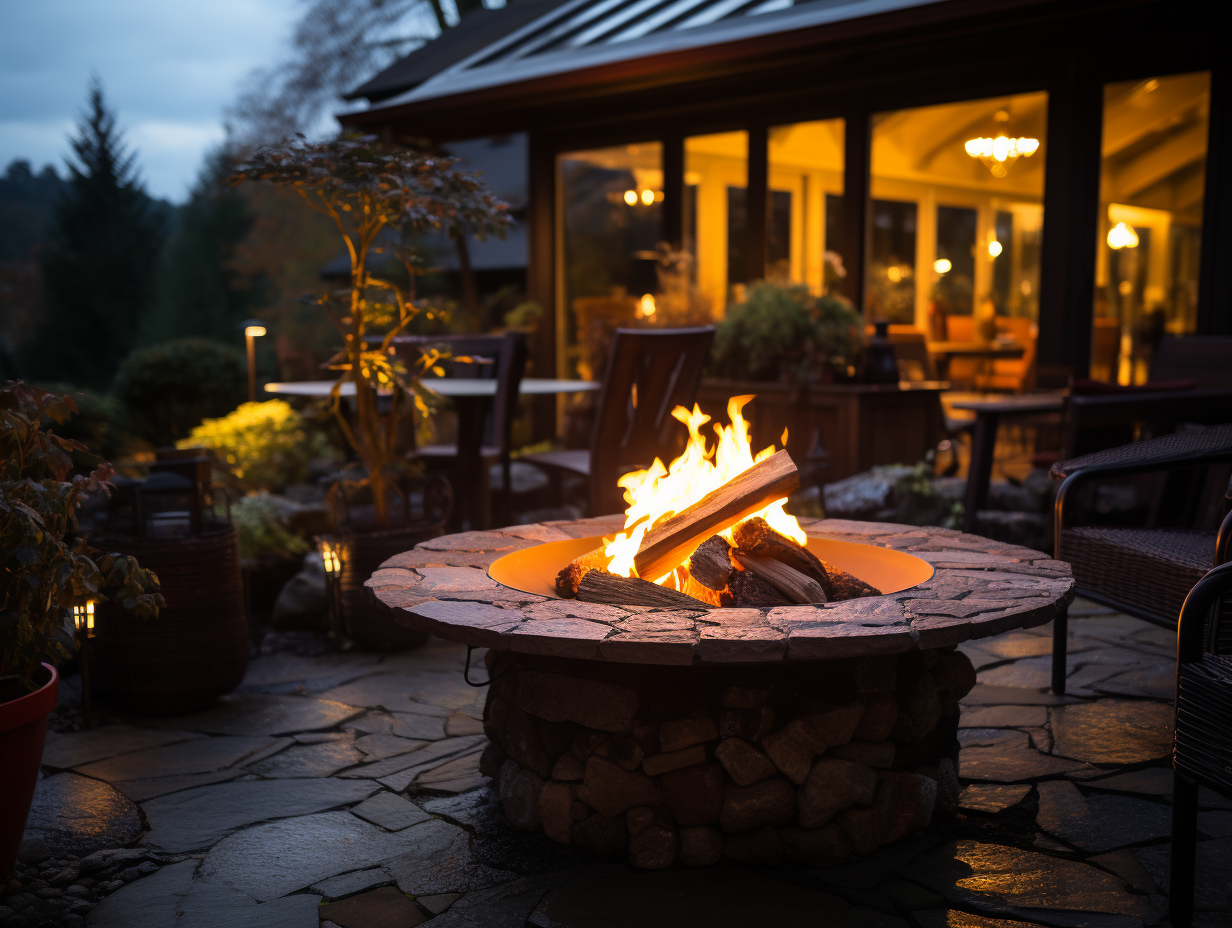
Are you thinking about installing a new patio? Have you decided on what material to use, but have no clue how much polymeric sand is needed for your job? If so, then this blog post is perfect for you.
I will go over the different types of pavers and their weight in order to help measure out how much polymeric sand that you need.
How Much Polymeric Sand Do I Need For A Patio?
The amount of polymeric sand applied to a patio will vary depending on the gap between the pavers. When laying stones with a tumbled edge, more polymeric sand is needed to fill the gaps than when laying pavers with a honed edge.
A 50-pound bag of polymeric sand will cover 75-100 square feet when used for tiny gaps. When filling broad gaps ranging from 1/4″ to 3/8″ wide, a 50lb bag will generally cover 30-60 square feet.
How Much Polymeric Sand Do I Need For A Patio?
| Patio Size | Tight Gaps | Wide Gaps | Total Area |
|---|---|---|---|
| 8 x 8 | 1 Bag | 2 – 3 Bags | 64 sqr ft |
| 10 x 10 | 2 Bags | 2 – 4 Bags | 100 sqr ft |
| 12 x 12 | 2 Bags | 3 – 5 Bags | 144 sqr ft |
| 16 x 16 | 3 – 4 Bags | 5 – 9 Bags | 256 sqr ft |
| 20 x 20 | 4 – 6 Bags | 7 – 14 Bags | 400 sqr ft |
When you have wider gaps, like with a flagstone patio, more sand will be required to fill them. A flagstone patio with big or uneven gaps may require a 50-pound bag for every 8-10 square feet.
It’s vital to double-check the coverage of the material you’re using; this is sometimes stated on the package.
Check Out Our Other Calculators:
- Free Concrete Slab + Bags Needed Calculator
- Free Pea Gravel Calculator
- Free Picket Fence Calculator
- Patio Paver Calculator + Cost
How Long Does Polymeric Sand Last?
Polymeric Sand (also known as Self-Grading Sand) is often used to fill patio pavers, but its lifespan depends on many factors.
General advice is that the life of polymeric sand ranges between 8 and 10 years. This time may be increased or reduced depending on how well it’s installed, how much traffic the area receives if weeds grow through the top surface of the product.
Some clients have reported 15+ years in certain areas. One important factor to consider when installing Polymeric Sand in an area is compaction.
If the ground where you are working is not compacted well enough then weed seeds can find their way through any gaps in your paving material and start growing.
If you are installing over an existing weed-infested area it is advisable to ensure that the soil is compacted well in order to minimize the chance of weeds growing through your paving material in the future.
Will Water Drain Through Polymeric Sand?
Polymeric sand, when installed correctly, hardens to keep your pavers in place and create a more effective weed and insect deterrent while yet allowing water to drain freely.
The sand is actually manufactured with “polymers” that bind the sand particles together and to the sand-soil base.
This creates a waterproof, soft wall around your pavers yet still allows water to drain freely away from the house so groundwater won’t become saturated and cause foundation problems or “heaving”.
There are several installation methods, and which method will work best for your area depends on the following:
1. Your soil type (sand or clay)?
2. The slope of the ground (water drains better on a slight grade).
3. How would you like to finish it? (painted, colored, capped with pavers)
Some contractors will use their own “home-brewed” recipe, yet there is one brand that has consistently proven itself in both dry and wet climates throughout the world… it’s called QUIKRETE®.
No matter where I am working worldwide, I can go to any supplier and get Quikrete Polymeric Sand in bulk due to its worldwide use by not only contractors but municipalities as well.
How Do You Maintain Polymeric Sand?
One of our most frequently asked questions is how to maintain Polymeric Sand. The answer to that question is quite simple – it’s just like any other sand surface.
The key difference with Polymeric Sand is that manufacturers recommend that you monitor and level your sand about once every month or so and re-apply if needed.
Why Is My Polymeric Sand Washing Out?
When too much water is used at once, the polymers might be washed away. A fragile joint may result from too little water during installation. The top layer of hardened sand might break and rapidly wash out of the joints after the first heavy rainfall.
More Reasons:
1. The curing process is too short. Often polymeric sand (Eco-Poly or Eco-Blast) can cure in as little as 24 to 48 hours, depending on the ambient temperature.
This leaves the surface susceptible to washout if not protected by a sealer during installation and before subsequent traffic.
The manufacturer recommends allowing 7 days without traffic for proper installation of the material (with or without mix).
2. Joints are cut between all pavers rather than staggered every other paver like traditional concrete joints. Without this unique stagger pattern, water can easily wash out of one joint and flood another causing damage to the surrounding area including sidewalks, patios, landscaping, etc.
This also makes it impossible to keep joints clean compared to the staggered joint pattern in the concrete.
3. The sand is too coarse or there’s too much aggregate in the sand mix. Coarse sand and high levels of aggregate (rocks, twigs, etc.) can prevent proper compaction and locking of the polymer particles together to form a monolithic structure that will accurately mimic natural soils like our native playa soil.
If you add too much water when mixing your own polymeric sand, it may result in a weak joint because water thins out the product.
Can Polymeric Sand Be Reapplied?
Polymeric sand is a substance that can be installed between pavers to help with traction and lock the stones together.
If you have an existing paver stone patio and want to apply more polymeric sand, it can be done as long as the previous application of polymeric sand is completely removed.
The process involves rinsing off any dirt or debris from your pavers, adding fresh sand if necessary, brushing it into each of the joints, and watering it down for a few minutes before letting it dry.
Does Polymeric Sand Harden Like Concrete?
Polymeric sand is very similar to concrete, but it doesn’t harden like concrete. It’s basically an emulsion of millions of minuscule polymer particles. Polymers are very large molecules that act like super glue when they get wet.
When you add water to polymeric sand (or any type of polymer), the polymer swells and starts grabbing onto anything permeated with water stain – like mortar between bricks, or dirt next to rocks in your foundation wall.
The polymer particles in polymeric sand also absorb water quickly, which causes them to expand and form hydrogen bonds between them. They then stick to loose soil like regular mortar sticks to bricks. This makes it extremely stable when under stress (like regular soils).
Can You Pressure Wash Polymeric Sand Pavers?
Yes, you can pressure wash pavers with polymeric sand as long as it’s been set and the pressure washer is on a low setting.
A pressure washer should not be used when the polymeric sand was installed on the same day.
When the polymeric sand was installed for more than 2 days, it should be okay. You can use a pressure washer while standing on the pavers to keep from accidentally digging up the sand and damaging the paver base layer.
The top layer of sand might get a bit wet, but it won’t damage anything.
How Big A Gap Can Polymeric Sand Fill?
Polymeric sand is most effective in filling gaps between 1/4 inch and 1.5 inches wide.
The thicker your application, period, the longer it will take to harden (i.e., dry). We recommend using Poly Sand in 1/4 inch applications during winter months when humidity is lower.
During summer months, you may find that 3/8″ or even 1/2″ thick applications cure adequately with less time and labor invested; however, the standard has become 1/4″.
When Should You Not Use Polymeric Sand?
You should not use polymeric sand for joints that are too narrow. Similarly, excessively wide joints might wash out since they allow excessive water flow during the activation procedure.
You should not use polymeric sands in joints that have an extensive network of cracks or pores filled with debris. This is because the soil has poor hydraulic conductivity and your efforts to restore it will be largely unsuccessful.
You should not use polymeric sands in joints that already have a good profile and do not need restoration.
In this case, the positive effects from the added polymer might be offset by raising the existing bottom line, which can compromise the stability of bike paths.
In addition, if you’re using asphalt pavements as an example, there may already be too much material at the surface to allow for resurfacing or compaction operations.
How Much Does It Cost To Install Polymeric Sand?
The cost of a polymeric sand job is highly dependent on the size of the area being sealed. It may seem unfair, but that’s just how it works when you’re working with a material that is capable of filling in cracks and crevices so seamlessly.
The cost of a full power wash and installation of polymeric sand and a wet-look sealer for an average-sized patio ranges from $1.35 to $2 per square foot, depending on the size.
The cost of a 50 lb bag of polymeric sand ranges between $20 and $40.With an average price of $30 in most areas.
Cost To Install Polymeric Sand
| Patio Size | Bags Needed | Total Cost (EX Labour) |
|---|---|---|
| 8 x 8 | 2 – 3 Bags | $60 – $90 |
| 10 x 10 | 2 – 4 Bags | $60 – $120 |
| 12 x 12 | 3 – 5 Bags | $90 – $150 |
| 16 x 16 | 5 – 9 Bags | $150 – $270 |
| 20 x 20 | 7 – 14 Bags | $210 – $420 |
How Long Does It Take For Polymeric Sand To Harden?
When exposed to large foot traffic and automobile traffic, the paver surface requires a minimum of 24 hours drying time before being utilized.
The primary goal of polymeric sand is to soften and re-heal. This is a very important step as it allows vehicles to traverse the fresh paver surface without creating any major damage or ruts.
When polymer-modified sand is used, 24 hours of drying time should be added before vehicular traffic can resume on the new concrete area.
This will give the binder in the polymers enough time to cure and harden after being applied.
Some manufactures will claim that their product does not require much if any drying time and can be walked on immediately, however, we have found much success with allowing at least 2 full days for curing and hardening before foot and vehicular traffic resumes on newly poured sidewalks and driveways.
Can I Use Regular Sand Between Pavers?
Yes, Regular sand (usually shown as #40 or #50) is intended to be used between pavers and concrete.
The reason for this is that the larger size of the gravel allows for movement in high-traffic areas while preventing weed growth.
If you use regular sand, such as beach or playground sand, it will compact and settle too quickly creating a weak base that will get pushed up over time by plant roots and other forces. It can also harbor weeds due to its finer texture.
What Happens If Polymeric Sand Gets Rained On?
When hard rain falls on polymeric sand that has not been completely set up, it might cover the top of the pavers and lift the polymeric sands out from the paving gaps.
The polymeric sand needs to be fully set up within the next 24 hours for it to remain stable on the top of the paver surface. If you instead use too much water pressure during cleaning, stones may come loose and dislodge from pavers.
Conclusion
Polymeric sand is a type of sand that has been mixed with polymers to create what they call durable sand.
Polymer sand can be used in landscape projects, such as playgrounds and walkways because it doesn’t get eroded by the rain or wind as traditional sand does. It also stays in place better than regular dirt and gravel would when people step on it.

![What Gravel To Use For Patio Base [Best Options]](https://www.cleverpatio.com/wp-content/uploads/2021/11/What-Gravel-To-Use-For-Patio-Base-270x180.jpg)


Leave a Reply